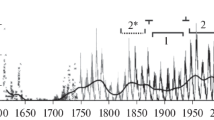Abstract
FOR almost two decades, Neptune's brightness varied inversely, at the level of a few per cent, with the solar cycle. The anticorrela-tion was so striking that some causal mechanism seemed necessary, and several suggestions were made1,2. Two different but plausible ideas involving solar-induced global changes in Neptune's atmosphere were a cyclic darkening ('tanning') of stratospheric aerosols caused by varying ultraviolet radiation3 and a variation in the rate of ion-induced nucleation of atmospheric aerosols due to the modulation of galactic cosmic-ray flux by solar activity4. In 1990, with the current solar cycle near its peak, however, Neptune departed unexpectedly from the previous cyclic behaviour, attaining its greatest brightness since 1972. Further observations will be needed to decide if the present deviation signals a unique atmospheric phenomenon, and to see if the cyclic anticorrelation will be restored.
Similar content being viewed by others
References
Lockwood, G. W. & Thompson, D. T. Nature 280, 43–45 (1979).
Lockwood, G. W. & Thompson, D. T. Science 234, 1543–1545 (1986).
Baines, K. H. & Smith, W. H. Icarus 85, 65–108 (1990).
Moses, J. I., Allen, M. & Yung, Y. L. Geophys. Res. Lett. 16, 1489–1492 (1989).
Lockwood, G. W. Icarus 32, 613–630 (1977).
Lockwood, G. W. in Handbook of Solar System Photometry (ed. Genet, R.) 2-1–2-19 (Willmann-Bell, Richmond, Virginia, 1983).
Joyce, R. R., Pilchec, C. B., Cruikshank, D. P. & Morrison, D. Astrophys. J. 214, 657–662 (1977).
Pilcher, C. B. Astrophys. J. 214, 663–666 (1977).
Lockwood, G. W., Thompson, D. T., Hammel, H. B., Birch, P. & Candy, M. Icarus (in the press).
Lockwood, G. W., Thompson, D. T., Lutz, B. L. & Howell, E. S. Astrophys. J. (in the press).
Slavsky, D. & Smith, H. J. Astrophys. J. 226, L49–L52 (1978).
Smith, B. A. in Uranus and Neptune (ed. Bergstralh, J. T.) 213–222 (NASA CP-2330, 1984).
Waldrop, W. M. Science 250, 1201 (1990).
Author information
Authors and Affiliations
Rights and permissions
About this article
Cite this article
Lockwood, G., Thompson, D. Solar cycle relationship clouded by Neptune's sustained brightness maximum. Nature 349, 593–594 (1991). https://doi.org/10.1038/349593a0
Received:
Accepted:
Issue Date:
DOI: https://doi.org/10.1038/349593a0
- Springer Nature Limited
This article is cited by
-
Solar-planetary cycles in Jupiter's great red spot darkness
Earth, Moon and Planets (1996)





